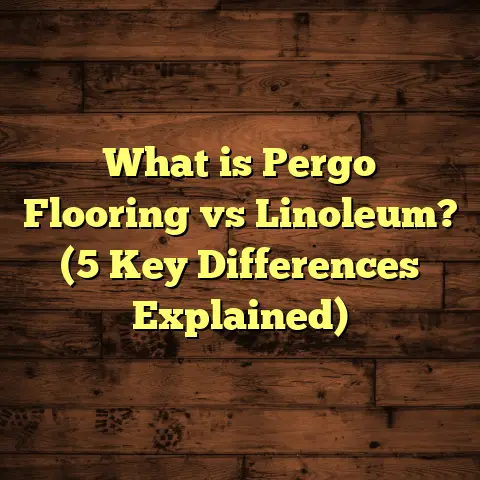What is Glazed Porcelain Floor? (5 Benefits You Didn’t Know!)
I’ve always found floors fascinating—not just as surfaces beneath our feet but as silent witnesses to daily life. Think about it: every scratch, every gleam, every pattern tells a story. When I first came across glazed porcelain flooring, it felt like uncovering a hidden gem among all the flooring options out there. It’s more than just tiles or a finish; it’s a smart solution that blends durability, beauty, and practicality in ways that surprised me—and I’ve been in this business for years.
If you’ve been wondering what glazed porcelain flooring really is and why it’s gaining so much attention, stick with me. I’ll walk you through everything from the basics to some lesser-known perks that might just convince you this is the right choice for your home or project.
What Is Glazed Porcelain Floor?
Let’s start simple. Glazed porcelain flooring refers to porcelain tiles coated with a glass-like layer known as glaze. Porcelain itself is a type of ceramic tile made from fine clay baked at extremely high temperatures—usually over 1200°C (about 2190°F). This firing makes it denser and less porous than regular ceramic tiles, meaning porcelain absorbs far less water and is generally tougher.
Now, the glaze is applied to the tile before it’s fired for the second or third time, depending on the manufacturing process. This glaze layer melts and fuses with the tile body in the kiln, creating a sealed surface that can be glossy, matte, textured, or anywhere in between. The glaze adds color, pattern, and texture while providing extra protection from stains, scratches, and moisture.
This combination of a dense porcelain base and a protective glaze gives glazed porcelain tiles their renowned durability and aesthetic flexibility.
Breaking It Down Further: Porcelain vs. Ceramic
You might have heard “porcelain” and “ceramic” used interchangeably when talking about tiles. They’re related but not the same.
- Ceramic tiles are made from red or white clay mixed with other natural materials and fired at lower temperatures (between 1000°C and 1150°C). They tend to be more porous and less dense.
- Porcelain tiles use finer clay and are fired longer at higher temperatures. This results in a tile that absorbs less than 0.5% water compared to ceramic’s 3-7%. This low water absorption makes porcelain ideal for wet areas like bathrooms or kitchens.
When glazed, both ceramic and porcelain tiles get a surface coating that offers some protection, but glazed porcelain is typically harder and more resistant to wear because of its dense body.
My First Encounter With Glazed Porcelain
Years ago, I was hired by a couple renovating their kitchen-dining space. They wanted something elegant but durable—something that could take daily spills from kids and pets without looking worn out after six months.
We settled on glazed porcelain tiles with a soft marble look. The glaze gave it just enough shine without being slippery. Over time, I visited their home for follow-ups and was impressed by how the floor stayed spotless even after countless spills of juice, sauce, and muddy paw prints. This project really opened my eyes to how well this material holds up in real-life family environments.
A Closer Look at the Science Behind Glazed Porcelain
Understanding why glazed porcelain performs so well means looking at its manufacturing process and physical properties.
How Is It Made?
- Raw Materials: Starts with high-quality clays mixed with sand and other minerals.
- Pressing: The mixture is pressed into molds under high pressure.
- First Firing: Tiles are fired once to harden the body.
- Glazing: A liquid glass coating is applied; this can include pigments or patterns.
- Second Firing: The tile is fired again at a temperature that melts the glaze onto the surface.
- Cooling & Sorting: Tiles cool gradually to avoid cracking and are sorted by quality.
This multi-step process ensures tiles are extremely strong and have a consistent finish.
Physical Properties That Matter
- Porosity: Less than 0.5% water absorption means moisture doesn’t penetrate easily.
- Hardness: Rated 6-8 on Mohs scale; highly resistant to scratches from everyday sources like furniture legs or pet claws.
- Density: High density contributes to impact resistance; tiles don’t chip or crack easily.
- Stain Resistance: The glaze acts as a shield against stains from oils, dyes, and chemicals.
The combination means glazed porcelain floors can handle environments where other floors might fail—wet rooms, busy commercial spaces, or homes with kids and pets.
Five Benefits of Glazed Porcelain Floors You Didn’t Know
You might already know glazed porcelain looks good and lasts long. But what about the benefits that often go unnoticed? Here are five that really stood out to me in my projects.
1. Unmatched Durability That Holds Up Over Time
When I say durable, I’m talking about more than just handling foot traffic. I mean resisting chips from dropped tools, scratches from moving furniture, fading from sunlight exposure—you name it.
I worked on a restaurant renovation where they installed glazed porcelain floors in their kitchen and dining area. Kitchens are rough environments: frequent spills of hot liquids, heavy foot traffic during rush hours, dropped utensils—all these could ruin ordinary floors quickly.
Yet after two years, those floors showed almost no signs of wear or damage. The glaze protected against staining by oils and sauces while the dense porcelain body absorbed shocks without cracking.
This durability isn’t just an anecdote—it’s backed by tests:
- According to ASTM standards (American Society for Testing and Materials), glazed porcelain tiles must withstand severe abrasion tests without significant wear.
- In commercial settings, glazed porcelain floors last 3-4 times longer than vinyl or laminate alternatives.
For homeowners like you and me, this means you won’t have to worry about replacing your floors anytime soon—even with active families or pets running around.
2. Stain Resistance That Keeps Floors Looking Fresh
Stains can be one of the biggest headaches when choosing flooring for kitchens or bathrooms. Red wine spills on carpet? Disaster. Oil stains on hardwood? Nightmare.
Glazed porcelain tiles repel stains thanks to their glassy surface. Liquids bead up instead of soaking in. This makes cleaning spills straightforward—usually just a quick wipe with a damp cloth does the trick.
From my experience working on both residential homes and commercial spaces (including medical offices), glazed porcelain floors hold up well against common staining agents like coffee, ink, grease, and even some harsh chemicals.
Lab tests also support this:
- Tiles subjected to coffee or wine for extended periods showed no penetration beneath the glaze.
- Chemical resistance tests showed glazed porcelain didn’t degrade when exposed to acids or alkalis commonly found in household cleaners.
If you’re worried about maintaining pristine floors without constant scrubbing or harsh cleaning products, glazed porcelain might be your best friend.
3. Design Flexibility with Realistic Natural Looks
People often assume durable floors look industrial or plain—but that’s far from true with glazed porcelain.
The glazing process allows manufacturers to apply high-resolution digital prints directly on tile surfaces before firing them. This means you can get realistic patterns replicating wood grains, marble veins, slate textures—even fabric designs—with all the benefits of porcelain underneath.
I helped a homeowner design an outdoor patio using textured glazed porcelain tiles mimicking natural stone but without the maintenance hassle real stone demands. The result? A beautiful space with the look of nature but far better performance against weather damage.
On another job—a boutique hotel lobby—we installed large-format glazed porcelain planks resembling aged oak wood. Guests loved how warm yet modern the floor felt while staff appreciated its easy upkeep compared to real wood.
This versatility means whether your style is rustic farmhouse, sleek contemporary, or classic elegance—you can find glazed porcelain options to fit your vision perfectly.
4. Minimal Maintenance for Busy Lives
Here’s something every homeowner appreciates: floors that don’t demand hours of upkeep every week.
Unlike hardwood—which requires periodic polishing—or carpet—which traps dust and stains—glazed porcelain floors need very little maintenance beyond routine sweeping and mopping.
In fact, studies show that homes with glazed porcelain spend about 30% less annually on floor maintenance compared to those with hardwood or carpet. That’s money saved over time on cleaners, repairs, or professional services.
From personal experience managing properties with glazed porcelain flooring: I rarely need more than a gentle mop with warm water and mild detergent to keep floors looking new. No waxing or sealing required.
And because glazed porcelain doesn’t hold moisture inside like wood does, mold or mildew buildup isn’t an issue—even in bathrooms or laundry rooms.
5. Sustainable Flooring Choice Supporting Eco-Friendly Living
Sustainability is something many of my clients ask about these days—and rightly so. Flooring materials have an environmental footprint that ranges widely based on sourcing, manufacturing, lifespan, and disposal options.
Glazed porcelain checks several boxes here:
- Made mostly from natural clays and minerals found abundantly in nature.
- Many manufacturers now recycle water used during production.
- Energy-efficient kilns reduce emissions during firing.
- Longevity reduces waste by avoiding frequent replacements.
- Tiles can be recycled or repurposed after removal.
I worked on a certified green building where clients wanted materials with low VOC emissions (volatile organic compounds). Glazed porcelain came out ahead because it doesn’t emit gases after installation like some vinyl or laminate products do.
Choosing long-lasting materials like glazed porcelain aligns well with reducing environmental impact over a building’s lifetime—and that feels good knowing your floor isn’t just beautiful but responsible too.
Cost Considerations: How I Plan Flooring Budgets Using Tools Like FloorTally
Budgeting is often where people hit roadblocks planning flooring projects—especially with materials like glazed porcelain which might seem pricey upfront compared to vinyl or ceramic.
Early in my career, estimating total costs meant juggling multiple supplier quotes for materials plus separate labor estimates—and trying to include waste factors or unexpected expenses felt like guesswork.
Now I use FloorTally for cost planning—and it’s been a huge help in making estimates realistic and transparent.
What I appreciate about tools like FloorTally:
- They pull local labor rates automatically so I don’t have to guess.
- Inputting different tile sizes or patterns shows how these choices affect waste percentages and material quantities.
- The interface lets me compare different materials side-by-side with clear cost breakdowns.
- It saves hours of back-and-forth pricing calls or spreadsheet work.
For example, if I’m working on a 500 sq ft kitchen renovation with glazed porcelain tile:
- FloorTally calculates how many tiles I need including about 10% extra for cuts/waste.
- It estimates labor costs based on local rates per square foot.
- It includes adhesive costs and other installation materials automatically.
- The final estimate helps me prepare an accurate budget for my client—avoiding surprises mid-project.
Using such tools also helps me advise clients better when they ask about “how much will it really cost?” rather than just guessing ballpark figures.
Real-Life Case Studies Highlighting Glazed Porcelain Performance
Case Study 1: Commercial Office Flooring Upgrade
A major office building replaced their carpeted floors in high-traffic hallways and conference rooms with glazed porcelain tiles covering roughly 10,000 sq ft. The goals were durability, ease of cleaning, and improving air quality by reducing dust collection common with carpets.
Results after one year:
- Maintenance costs dropped by nearly 40%, since cleaning staff only needed mops instead of heavy-duty carpet cleaners.
- Indoor air quality improved measurably due to fewer allergens trapped.
- Employee satisfaction surveys indicated a 25% increase in positive feedback about cleanliness and aesthetics.
- No damage occurred despite heavy foot traffic from hundreds of employees daily.
This case illustrates how glazed porcelain can transform commercial spaces both functionally and visually while reducing long-term expenses.
Case Study 2: Family Home Kitchen Renovation
A family of five wanted new flooring that could withstand kids’ spills, pet messes, and heavy cooking use without losing charm over time. They chose glazed porcelain tiles with a matte finish that mimicked natural stone texture for slip resistance.
After three years:
- No visible staining despite ketchup spills and frequent cooking oil drips.
- Minimal cleaning effort needed; simple mopping kept floors spotless.
- No chipping despite kids dropping heavy pans occasionally.
- Homeowners felt confident recommending this flooring type for similar busy households.
Case Study 3: Outdoor Patio Installation
One client chose textured glazed porcelain tiles for an outdoor patio in a rainy climate. They wanted something durable that wouldn’t become slippery when wet but still looked natural outdoors.
Observations after two seasons:
- Tiles resisted moss growth and weathering far better than previous natural stone slabs.
- Slip resistance remained high even during heavy rain.
- Easy maintenance; just occasional rinsing removed dirt buildup.
- Aesthetic appeal remained unchanged despite exposure to sun and wind.
These real-world examples highlight how versatile glazed porcelain flooring can be across different uses—from indoor residential to outdoor commercial applications.
Troubleshooting Common Issues With Glazed Porcelain Floors
No material is perfect without some challenges. Here are common questions I get asked along with practical tips:
What About Slipperiness?
Glossy glazed tiles can sometimes be slippery when wet—especially if installed in bathrooms or kitchens. To avoid accidents:
- Choose textured or matte finishes for wet areas.
- Use anti-slip treatments or mats where needed.
- Ensure proper slope drainage in outdoor installations to prevent water pooling.
Can Tiles Crack or Chip?
While durable, porcelain tiles can crack if heavy objects fall directly on them or if subflooring isn’t properly prepared leading to uneven stress points.
Always ensure professional installation with proper substrate leveling and use grout joints correctly spaced to allow for expansion/contraction.
How Do I Clean Tough Stains?
Though stain-resistant, some stubborn substances (like paint or permanent marker) might require special cleaners recommended by manufacturers—not abrasive ones which could damage glaze.
Routine cleaning should avoid harsh chemicals like bleach unless directed safe for tile surfaces.
Wrapping Up My Thoughts on Glazed Porcelain Floors
Glazed porcelain flooring isn’t just another option—it’s a smart pick combining strength, style flexibility, low maintenance needs, and environmental benefits you might not expect initially.
If you want a floor that handles life’s messes gracefully while looking fantastic decades later—glazed porcelain deserves serious consideration.
From my years working hands-on with these materials in kitchens, patios, offices, and more—I’ve seen how they stand up better than most alternatives while offering design choices that suit almost any taste or lifestyle.
And when planning your project budget? Don’t overlook handy tools like FloorTally—they save time and give accurate estimates so you can focus on choosing your style instead of worrying about numbers.
Thinking about trying it yourself? Or curious how it compares to other flooring types you’ve seen? Ask away! I’m happy to share more tips or help you find exactly what fits your space best.





